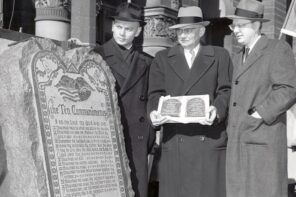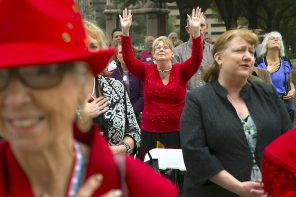“Ten years ago I was praying on a mountaintop,” says a pasty-faced Richard Gazowsky, his words illustrated with scenes of a church-top cross on a cloud-strewn night. “The Lord spoke to me, like out of the blue: You will start a film company. I want you to be the Rolls Royce of filmmaking, be better than anyone in the world… I believe God has given us a vision.”
So begins Michael Jacobs’ Audience of One, a documentary that follows the charismatic, avuncular pastor of a San Francisco Pentecostal Church on his divine mission to make a multimillion-dollar science-fiction film based on the biblical story of Joseph.
But this won’t be just any film, Gazowsky promises. Gravity: The Shadow of Joseph, as his film is titled, will be so monumental, so inspired and otherworldly, it will change the process of moviemaking and shatter the expectations of film audiences everywhere. For the initial funding, Gazowsky manages to raise hundreds of thousands of dollars from churchgoers and anonymous donors, with the promise of millions more to come from a mysterious donor in Germany. Their task: to produce a visionary film for the spectator on high—as Gazowsky constantly reminds us—“an audience of One.” And so the members of Christian WYSIWYG Productions set off, a ragtag troupe of family members, church members, and volunteer actors plucked from Craigslist, along with a couple of professional technicians and a largely invisible independent filmmaker (whose role is to chronicle the making of the greatest Christian movie—or greatest movie, period—ever made.)
From the beginning you know their endeavor is the stuff of documentary, spectacular either as a success or a flop. The group encounters the kind of tribulations you might expect a mostly nonprofessional cast taking on a Hollywood epic to encounter, or, for that matter, a small group of believers wandering in the wilderness. Cameras jam. Sets crumble. Promised funds never materialize. Cast and crew members quit. And, in the beautifully medieval Italian town of Alberobello where the only two scenes of the epic movie are ever shot, Italian extras regard Gazowsky with befuddled disinterest as he attempts to direct and lead them in prayer. In the eyes of his followers, every minor success is a miracle, every major glitch a trial or the work of a sinister force. Finally, as the city of San Francisco moves to evict the group from their massive Treasure Island production studio, even the project’s most devout believers begin to experience a gnawing sense of doubt. Is Gazowsky himself the single audience member for whom this film, at incredible sacrifice to all involved, is being made?
For every setback, Gazowsky promises his followers ever-greater rewards, ever-loftier goals at his sermons. The budget doubles from $50 to $100 million, and then doubles again to $200 million. The (as-of-yet unmade) film is just the beginning of a journey that will have them owning a Christian theme park, an airline, a series of television stations; they will be the first to colonize another planet. Each new revelation is greeted with enthusiastic shouts and frenzied applause.
Throughout it all, Jacobs’ camera captures, with stark verité detachment, the trials of the small community making the film, and dwells on the character of its leader. Who is Pastor Richard Gazowsky? Is he a megalomaniacal swindler or a divinely inspired visionary? Or is he “a sweet man… very naive and very gentle,” as his mother and former Voice of Pentecost pastor tells us? It’s a question even Gazowsky himself honestly can’t seem to answer. At one point, as he reveals to his congregation the larger journey beyond the making of the film, he says in an affected whisper, “Can I tell you something? If you’re really hearing from God, there’s a minute there where you’re just going to say, ‘You know what? It’s either God… or I’m crazy.’”
And there you have the crux of it. Either he’s crazy, he’s lying, or he’s been given the directorial nod from the Celestial Auteur.
Absent from Audience of One is the central text. There are no scenes from Gazowsky’s epic Gravity, no summary of its plot. We get only broad outlines of what the divinely inspired film will be about: It will be set in the future, a future much like the biblical past. It will be “Star Wars meets the Ten Commandments.” We see glimpses of sets, medieval-looking costumes, sketches of strange creatures, and fragments of dialogue. The closest we get to seeing an actual scene from Gravity occurs in Italy, where the cast, crew and several hundred Italian extras spend a disastrous week attempting to shoot on a very tight schedule. Working day and night, they’re able to turn out a total of two brief scenes for the film.
What we do know is that the story is based on the biblical tale of Joseph, the favored, goody-two-shoes son whose jealous brothers plan to murder him, but end up selling him into slavery in Egypt. In case you don’t remember how that turned out, Joseph does some prison time until his flair for dream interpretation is recognized by the Pharaoh, who appoints him Viceroy in thanks. It’s a decades-spanning, riches to rags to worse rags to riches story fraught with tribulation, self-doubt, and ultimately, salvation.
“The easy parallel,” says Audience of One director Michael Jacobs, “Is that my film follows a man on a journey where he goes through a tremendous amount of hardships, hopefully ultimately for the sake of redemption and for love… and [Pastor Gazowsky’s] film is based on the same thing.”
And before you dismiss Gazowsky’s vision as just the ramblings of yet another outsider independent filmmaker, there may be reason to trust in the Pastor yet.
“I love what [Christian WYSIWYG Productions does] creatively,” says Jacobs, adding that he has the footage from Gravity that was shot on the disastrous trip to Italy. “It’s fantastic. It shows Richard’s vision of shooting at this beautiful high resolution. It also shows the amazing set that he picked out in Italy… It’s very cinematic. It’s very elegant. It’s bizarre, but it’s beautiful and bizarre.” The clips will be screened at the documentary’s opening, and will be included as extras on the DVD.
If, as he tells us, Pastor Gazowsky’s intention is to set his viewers in a fantastical parallel-but-alien world in order to stun them into engaging with biblical themes, Audience of One seems to be working toward a similar goal. Director Michael Jacobs spent two years with Voice of Pentecost, filming the cast and crew of Gravity. For Jacobs, a nonpracticing Jewish kid from Boulder, Colorado, who describes himself as “sometimes agnostic, sometimes atheist, depending on the day,” Gazowsky’s world was as faraway a land as he could have imagined.
“When I walked into that church the first time, I may as well have been stepping onto another planet,” he says. “It was like a foreign country, you know. And far stranger than some foreign countries. The way that they operate… It was just so different.”
The intensely intimate scenes at Voice of Pentecost, the speaking in tongues, the heated prayer circles that boil over into anguished pleading and spasmodic twitching, the church members filled with the Holy Spirit, rolling on the ground —all of this will be as foreign to many viewers as the practices of Planet Naboo, and far less comfortable. It’s at these moments that the film is most challenging. You either dismiss their vision as the delusional ravings of a misled sect, or you have faith that there may be the hand of God somewhere in there.
True to the director’s agnostic ideals, there is little guidance provided by Jacobs’ camera.
“I set out to follow a guideline of cinema verité and the American cinema verité pioneers, who were rarely in their films,” says Jacobs, then adds: “Also, I’m still confused about how I feel about the whole thing… I didn’t want to get in the way of myself.”
Audience’s unadorned, natural aesthetic is an interesting counterpoint to the highly-produced epic whose filming it chronicles, just as Jacobs’ rigidly objective directorial style is in stark contrast with that of the larger-than-life director he examines. In fact, Jacobs’ camera is meek to the point of self-effacing—except for a murmured question thrown out to a cast member here and there, Jacobs is almost completely absent. His camera leaves WYSIWYG’s cast of eccentric characters exposed to the viewer’s interpretation as foolish, brave, naive, ridiculous, whatever. All of which leaves his audience with the task of individually assessing Gazowsky, his film, and the Voice of Pentecost on their own terms, each spectator an uncomfortably entertained audience of one.



